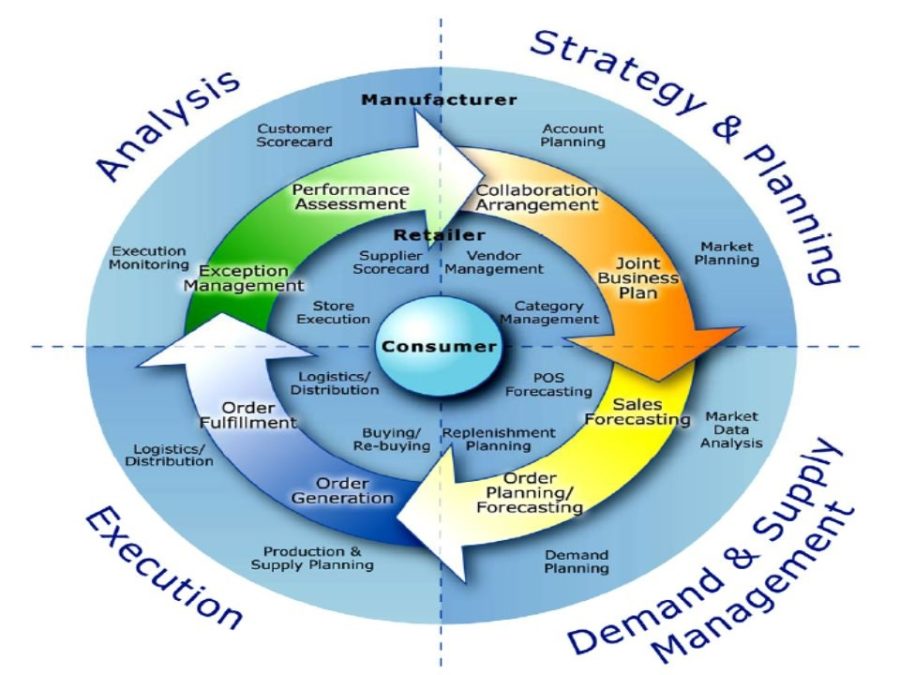Collaborative Planning, Forecasting and Replenishment (CPFR) is defined as a business practice that combines the brainpower of two or more trading partners in planning the ways to fulfill the customer demand. They also explained the relationship that CPFR links best practices of sales and marketing, such as category management, to the implementation of supply chain planning and completion process, to increase availability while reducing inventory, transportation and logistics costs. Basically CPFR is an approach that deals with the requirements for good demand management. The most involved industries with CPFR are consumer products and food and beverage.
The main objective of Collaborative Planning, Forecasting and Replenishment (CPFR) is to “optimize” the supply chain process by:
- Improving accuracy of forecasting demand,
- Delivering the right product at the right time to the right location,
- Reducing inventory,
- Avoiding stock outs, and
- Improving customer service.
But the most important fact on which the achievement of objective and activities of CPFR depend is to have collaborative trading partners who share risk and information mutually in the whole process. Without Collaborative planning and forecasting between the trading partners will make the supply chain “suboptimal”, thus will result in less-than-maximum supply chain profits. It is observed that forecasting developed only by firm tends to be inaccurate most of the time so therefore in CPFR when both the buyer and seller collaborate in forecasting, then it makes possible to match buyer needs with supplier production plans, thus ensuring competent replenishment. CPFR also helps in avoiding expensive corrections after the fact when demand or promotions have changed.
Benefits of CPFR:
- Strengthens supply chain partner relationships.
- Provides analysis of sales and order forecast which improves the forecast accuracy.
- Manage the demand chain and proactively eliminate problems before they appear.
- Allow collaboration on future requirements and plans.
- Combine planning, forecasting and logistic activities.
- Provides efficient category management and understanding of consumer purchasing patterns.
Challenges for CPFR implementation
There are top three difficulties faced by organizations in implementing CPFR:
- Making internal changes: Internal changes must always be tackled by top management as change is always difficult but if the top management is dedicated to the project and in educating employees about the benefits of CPFR then there are more chances of getting a successful internal change.
- Total implementation cost: Although cost is an important factor to be considered always but companies must determine whether they are at a competitive disadvantage.
- Trust: It is one of the biggest hurdles in general implementation of CPFR as many retailers are unwilling to share the information required to implement CPFR.
Collaborative Planning, Forecasting and Replenishment (CPFR) Process Model
The Collaborative Planning, Forecasting and Replenishment (CPFR) reference model provides a framework for planning, forecasting and replenishment process. Figure below represents the framework components. A buyer and a seller work as Collaboration Partners and work together to satisfy the customer demand which at the centre of the model.
The key Collaborative Planning, Forecasting and Replenishment (CPFR) activities to enhance performance of Collaboration partners are –
- Strategy & Planning – Establish the rules for collaborative relationship. Determine the product mix and develop event plans for the period.
- Demand and Supply Management – Project consumer (POS) demand, as well as order and shipment requirements over the planning period.
- Execution – Place orders, prepare and deliver shipments, receive and stock products in retail stores, record sales transactions and make payments.
- Analysis – Monitor planning and execution activities for exception conditions. Aggregate results and calculate KPI’s. Share insights and adjust plans for better performance.
